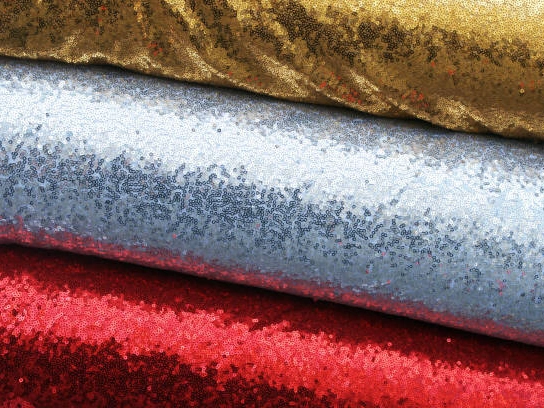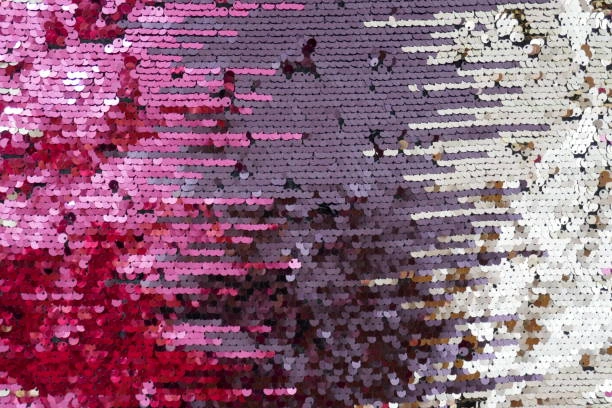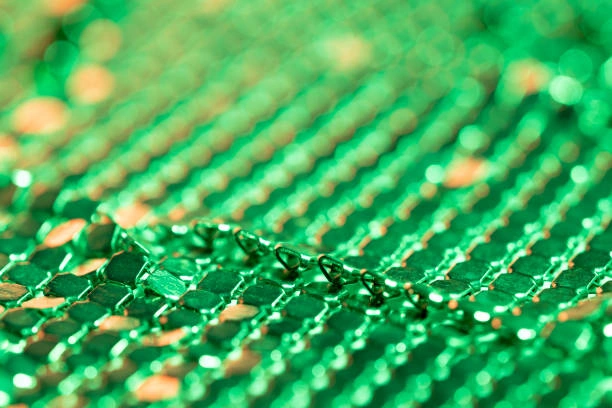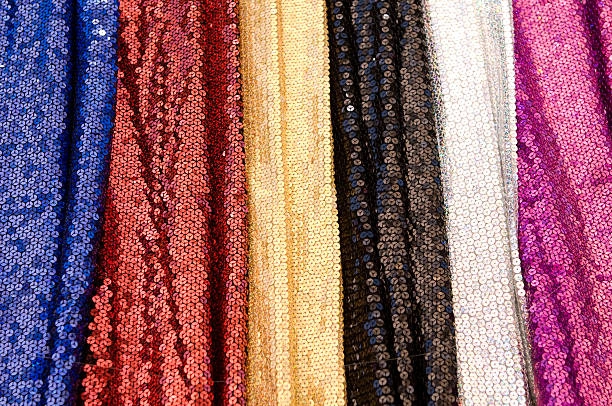Have you ever found the perfect sequinned fabric, only to find out the colour doesn’t match your imagination? It can be frustrating when your creativity is limited by a limited palette of colours. We’ll explore whether it’s possible to dye sequined fabric at home, and what methods can be used to create stunning personalised effects.
What is Sequin Fabric

Most sequins are made from plastics, such as PVC or PET. These materials are generally non-porous and will not absorb traditional fabric dyes. Think of dyeing a plastic bottle – it won’t work the same way as natural fibers. This means that when you try to dye a sequined fabric, your primary goal is to change the color of the underlying fabric, not the sequin itself. The original color of the sequin will be retained, creating a fascinating two- or multi-color effect, which can be very beautiful if that’s your intention.
However, some very special sequins, typically those with a more matte finish or made from cellulose-based plastics (which is rare in typical craft sequins), may absorb a small amount of dye, creating a subtle hue. But for the vast majority of sequined fabrics, color changes can be expected to be limited to the underlying fabric. This is crucial to setting realistic expectations when you set out to dye sequined fabrics.
Pre-Dyeing Preparation

Proper preparation is absolutely critical when you want to dye sequin fabric successfully. Skipping these steps can lead to uneven results or damage to your fabric.
First, clean your sequin fabric thoroughly. Even new fabric can have sizing, oils, or dirt that will impede dye absorption. I recommend hand-washing the fabric gently in cool water with a mild, pH-neutral detergent. Avoid harsh scrubbing or wringing, as this can damage the sequins or detach them from the base. Rinse thoroughly until the water runs clear. This initial cleaning ensures the base fabric is perfectly receptive to the dye.
Next, check the fiber content of your base fabric. This is the single most important factor in determining what type of dye you’ll use. Common base fabric materials include:
- Natural Fibers: Cotton, rayon, linen, silk, wool. These are generally the easiest to dye and absorb fiber-reactive or natural dyes well.
- Synthetic Fibers: Polyester, nylon, spandex, acetate. These are much trickier to dye and often require specialized dyes designed for synthetics, or they may not dye at all. Nylon can sometimes take acid dyes, but polyester is notoriously resistant to home dyeing.
You can often find the fiber content on the fabric bolt’s label or by asking the fabric store staff. If you’re unsure, a simple burn test on a small, unnoticeable scrap can help identify natural vs. synthetic fibers. Understanding your base fabric is key to knowing how to dye sequin fabric effectively.
Finally, protect your workspace. Dyeing can be messy! Lay down old newspapers, plastic sheeting, or a tarp. Wear rubber gloves to protect your hands and old clothes you don’t mind staining. Have paper towels or old rags handy for spills. This preparation ensures a smooth and less stressful dyeing experience.
Choosing Your Dye: Matching Dye to Fabric Type
Selecting the correct dye is paramount for successful results when learning how to dye sequin fabric. As I mentioned, the base fabric dictates the dye type.
For natural fibers (cotton, rayon, linen, silk, wool), I highly recommend fiber-reactive dyes (like Procion MX). These dyes form a permanent chemical bond with the fabric fibers, resulting in vibrant, long-lasting, and wash-fast colors. They are user-friendly for home dyeing and provide excellent results. Natural dyes can also be used, but they require more extensive knowledge of mordants and processes. If you’re looking for the best way to dye sequin fabric with a natural fiber base, fiber-reactive dyes are my top choice.
For synthetic fibers (polyester, acetate, acrylic), your options are much more limited for home dyeing. Polyester is exceptionally resistant to dye at low temperatures. You generally need disperse dyes which require high heat (often boiling temperatures) to penetrate the fibers. This presents a challenge with sequin fabric, as high heat can melt or distort plastic sequins. Acetate and nylon can sometimes take acid dyes, but results can be unpredictable and heat-sensitive. For most synthetic sequin fabrics, I often find that dyeing isn’t a viable option without professional equipment or a high risk of damaging the sequins. It’s important to have realistic expectations when trying to dye sequin fabric that has a synthetic base.
Consider also the color you’re trying to achieve. If your base fabric is light, you can dye it almost any color. If it’s already a dark color, you’ll need to consider color theory – you can’t dye black fabric light pink, for instance. You can only dye darker over lighter colors.
How to Dye Sequin Fabric

This is our go-to method for dyeing natural fiber-based sequin fabrics, and I find this method gives the most consistent and beautiful results.
Prepare the dyebath: In a large plastic bucket or stainless steel pot (don’t use it to hold food), mix the reactive dye according to the manufacturer’s instructions. This usually involves dissolving the dye powder in hot water, then adding soda ash (dye activator) and salt (to help even absorption). Make sure all ingredients are thoroughly mixed. The dyebath should be large enough to allow the fabric to move freely without crowding.
Wet the fabric: Thoroughly wet the clean sequin fabric with warm water before placing the fabric in the dyebath. This helps the dye absorb evenly and prevents blotching. Gently squeeze out any excess water, but keep the fabric damp.
Place the fabric in the dyebath: Carefully dip the damp sequin fabric into the prepared dyebath. Use a stirring stick or tongs to gently stir the fabric to ensure the dye penetrates evenly. This is essential to prevent streaking and get an even color. I like to keep the fabric moving for the first 10-15 minutes, and then move it regularly for the remainder of the dyeing time.
Dyeing Time: Soak the fabric in the dye solution for the recommended time, usually 30-60 minutes, or longer if the color is darker. The longer it soaks, the darker the color. Keep in mind that the sequins themselves will not change color, but the base fabric will. Keep a close eye on the color development.
Rinse Thoroughly: Once the desired color is reached, carefully remove the sequined fabric from the dye solution. Rinse in cold water until the water runs completely clear. This may take some time, especially when dyeing a darker color. Continue to rinse gently to remove all excess dye.
Washing and Drying: After rinsing, hand wash the sequined fabric again with a mild detergent and cold water. This final wash removes any remaining unbound dye. Finally, lay the fabric flat or hang it to dry, away from direct sunlight or high temperatures to avoid damaging the sequins. Do not use a dryer unless the fabric care instructions specifically allow it, as high temperatures can melt plastic sequins.
Troubleshooting for Dyeing Sequin Fabric

Even with careful planning, sometimes challenges arise when trying to dye sequin fabric. Here are some common issues and advanced tips I’ve learned along the way:
- Uneven Dyeing/Splotches: This usually indicates that the fabric wasn’t wet enough before entering the dye bath, or it wasn’t agitated sufficiently during the dyeing process. Ensure thorough pre-wetting and continuous movement of the fabric in the dye bath, especially during the first 15-20 minutes.
- Sequins Melting/Distorting: This is almost always due to excessive heat. If you’re trying to dye synthetic base fabrics that require high-heat dyes, carefully consider if the sequins can withstand those temperatures. Always do a small test swatch first. This is a primary reason why dyeing polyester sequin fabric at home is often not recommended.
- Dye Not Taking (on Base Fabric): This points to either an incorrect dye type for your base fabric (e.g., using a fiber-reactive dye on polyester) or insufficient preparation (e.g., fabric not clean, no soda ash for fiber-reactive dyes). Double-check your fiber content and dye instructions.
- Sequins Becoming Brittle/Detaching: This could be due to harsh chemicals in the dye, excessive agitation, or simply old/fragile sequins. Handle the fabric as gently as possible throughout the entire process.
Dyeing Sequin Fabric Advanced Tips:

- Test Swatch: Always, always, always test a small, inconspicuous swatch of your sequin fabric first before dyeing the entire piece. This allows you to check color uptake, observe how the sequins react, and fine-tune your process. This is the best way to dye sequin fabric with confidence.
- Overdyeing: If your base fabric is already colored, remember that you’re overdyeing. The original color will mix with the new dye. For example, dyeing a yellow base with blue dye will result in green. Plan your color combinations carefully.
- Creating Ombre Effects: For a gradient look, slowly lower or raise the sequin fabric into/out of the dye bath. This requires careful timing and agitation.
- Embracing the Two-Tone Effect: Since sequins don’t typically dye, embrace the contrasting or complementary color effect this creates. This unique characteristic can be part of your design.
- Consider Fabric Paint for Synthetics: If your base fabric is synthetic and resistant to dye, or if you only want to color some areas, fabric paint might be a better alternative. You can carefully paint the base fabric between the sequins, though this is a much more laborious process and results in a different texture.
What Fabrics Cannot Be Dyed?
Generally, fabrics that are inherently non-porous or chemically treated to repel liquids are difficult or impossible to dye effectively at home.
Here are some common types:
Fabrics with Rubber Backings: These usually do not dye well due to the non-porous rubber.
100% Polyester: This synthetic fiber is notoriously resistant to most home dyes because its fibers are not easily penetrated by dye molecules at typical home dyeing temperatures. Specialized disperse dyes are required, often needing boiling water, which can damage other materials.
100% Acrylic: Similar to polyester, acrylic fibers are synthetic and do not readily absorb standard fabric dyes.
Fiberglass: This material is made of glass fibers and is completely non-absorbent to dye.
Metallic Fibers: Fabrics incorporating metallic threads are not dyeable, as the metal itself cannot absorb dye.
Waterproofed, Stain-Resistant, or Coated Fabrics: Any fabric treated with a finish (like Scotchgard) to repel water or stains will also repel dye, resulting in very poor or no color absorption.
Conclusion
Learning how to dye sequin fabric can be a rewarding experience, opening up a world of custom color possibilities for your projects. By understanding the materials, preparing carefully, and choosing the right methods, you can achieve stunning and unique results. Happy dyeing!
